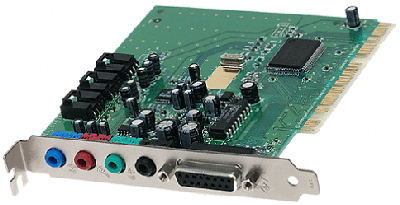
Creative Labs SB4740 Sound Blaster 16 PCI
|
Often, different brands of sound cards from different manufacturers use the same chipset. The basic chipset comes from a third-party vendor. The sound card manufacturer then adds various other functions and bundled software to help differentiate their product.
Sound cards may be connected to:
- headphones
- amplified speakers
- an analog input source
- microphone
- radio
- tape deck
- CD player
- a digital input source
- digital audiotape (DAT)
- CD-ROM drive
- an analog output device - tape deck
- a digital output device
Some of the current high-end sound cards offer four-speaker output and digital interface through a jack. For audiophiles, there is a new generation of digital sound cards. A digital sound card is practical for applications that need digital sound, such as CD-R and DAT. Staying digital without any conversion to or from analog helps prevent what is called "generational loss." Digital sound cards have provisions for digital sound input and output, so you can transfer data from DAT, DVD or CD directly to your hard disk in your PC.
Catching The Wave
Typically, a sound card can do four things with sound: - play pre-recorded music (from CDs or sound files, such as wav or MP3, games or DVDs
- record audio in various media from external sources (microphone or tape player)
- synthesize sounds
- process existing sounds
The DAC and ADC provide the means for getting the audio in and out of the sound card while the DSP oversees the process. The DSP also takes care of any alterations to the sound, such as echo or reverb. Because the DSP focuses on the audio processing, the computer's main processor can take care of other tasks.
Early sound cards used FM synthesis to create sounds. FM synthesis takes tones at varying frequencies and combines them to create an approximation of a particular sound, such as the blare of a trumpet. While FM synthesis has matured to the point where it can sound very realistic, it does not compare to wavetable synthesis. Wavetable synthesis works by recording a tiny sample of the actual instrument. This sample is then played in a loop to re-create the original instrument with incredible accuracy. Wavetable synthesis has become the standard for most sound cards, but some of the inexpensive brands still use FM synthesis. A few cards provide both types.
Very sophisticated sound cards have more support for MIDI instruments. Using a music program, a MIDI-equipped music instrument can be attached to the sound card to allow you to see on the computer screen the music score of what you're playing.
Producing Sound
Let's say you speak into your computer's microphone. A sound card creates a sound file in wav format from the data input through the microphone. The process of converting that data into a file to be recorded to the hard disk is: - The sound card receives a continuous, analog-waveform input signal from the microphone jack. The analog signals received vary in both amplitude and frequency.
- Software in the computer selects which input(s) will be used, depending on whether the microphone sound is being mixed with a CD in the CD-ROM drive.
- The mixed, analog waveform signal is processed in real-time by an analog-to-digital converter (ADC) circuit chip, creating a binary (digital) output of 1s and 0s.
- The digital output from the ADC flows into the DSP. The DSP is programmed by a set of instructions stored on another chip on the sound card. One of the functions of the DSP is to compress the now-digital data in order to save space. The DSP also allows the computer's processor to perform other tasks while this is taking place.
- The output from the DSP is fed to the computer's data bus by way of connections on the sound card (or traces on the motherboard to and from the sound chipset).
- The digital data is processed by the computer's processor and routed to the hard-disk controller. It is then sent on to the hard-disk drive as a recorded wav file.
To listen to a prerecorded wav file, the process is simply reversed:
- The digital data is read from the hard disk and passed on to the central processor.
- The central processor passes the data to the DSP on the sound card.
- The DSP uncompresses the digital data.
- The uncompressed, digital data-stream from the DSP is processed in real-time by a digital-to-analog converter (DAC) circuit chip, creating an analog signal that you hear in the headphones or through the speakers, depending on which is connected to the sound-card's headphone jack.

